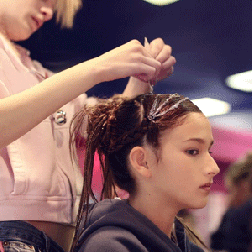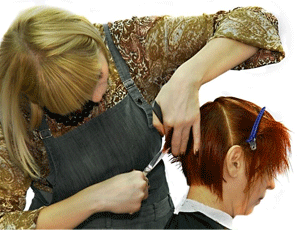 No matter how difficult times are, people will
still have to take care of their personal appearance; hence there will
always be a need for barbers. A barber is a personal appearance worker
who cuts or trims hair for mainly male clientele, as well as providing
services such as fitting hairpieces like wigs and toupees and facial
shaving and scalp treatments. Depending on their qualifications, they
may also dye or bleach hair, provide permanent waves and offer skin and
nail care treatments. Barbers are well-compensated for their work; on
the average, a barber can earn $11.56 an hour, with those in the top
10% of their professions able to command close to $20 an hour. While
many barbers are employed in salons or barbershops, almost half of them
are self-employed, running their own practices.
No matter how difficult times are, people will
still have to take care of their personal appearance; hence there will
always be a need for barbers. A barber is a personal appearance worker
who cuts or trims hair for mainly male clientele, as well as providing
services such as fitting hairpieces like wigs and toupees and facial
shaving and scalp treatments. Depending on their qualifications, they
may also dye or bleach hair, provide permanent waves and offer skin and
nail care treatments. Barbers are well-compensated for their work; on
the average, a barber can earn $11.56 an hour, with those in the top
10% of their professions able to command close to $20 an hour. While
many barbers are employed in salons or barbershops, almost half of them
are self-employed, running their own practices.
Barbers and other personal appearance workers are required to acquire a license from the state before being allowed to practice; licensing requirements vary from state to state. At a minimum, barbers who want to become licensed must possess at least a high school diploma or equivalent qualification, be at least 16 years old and have completed a state-licensed barber training program. These are commonly found at public high schools as well as private and public secondary vocational schools. A full-time barbering program commonly takes nine months to two years to complete and may result in the award of an associate degree although many programs simply provide a certificate.
Upon successful completion of the program, students must take a state licensure examination. The licensing test commonly consists of a written component and a practical examination in which the student is required to demonstrate their skills, or alternatively, an oral examination. If the student has had some cosmetology training, this may also be credited towards a barber's license. Depending on the requirements of the state, once the barber has received his license, he may periodically have to renew it.
When selecting a barber training program, the student must make sure that the program is approved by the state to ensure that they will get the qualifications they need to become licensed. Since barbers must also have good relations with their customers, students who feel they might need more training in customer relations skills might want to seek out programs that also offer courses in the psychology of human relations. If they intend to start their own barber shop after completing the program, students should also consider taking additional courses in business management and finance.
Apart from formal training, student barbers must also undertake an apprenticeship program that will provide them with on-the-job experience. The program should provide the student training in the full range of services barbers these days offer, which may include manicures and pedicures, facial treatments and hair coloring services. Students may sign up for apprenticeship programs at the school in which they are receiving their training or through trade unions that may be offering such programs. Depending on the program, they may have to pay minimal fees for participation, and of course, provide their own equipment.
Barber Training Programs are a Must for Student Barbers to Get Licenses to Practice.
Becoming a barber can provide you with a very rewarding professional life. Choosing the right barber school is probably one of the most important decisions in your barber career. Find the best barber schools, visit bestofcolleges.com
 Barbering is one of the world's oldest
professions, dating back to at least the Bronze Era when razors were
found among relics unearthed in Egypt which dated back to this period.
While the common perception is that barbers merely cut and style hair,
in fact they offer a wide range of services, including shaves, scalp
massages, hair coloring, bleaching and highlighting as well as
manicures and pedicures. Barbers are among the best compensated of
personal appearance workers, earning an annual average of $24,781,
although this may vary depending on where the barber is practicing and
their level of skill and experience. Professional barbers are required
to get training from state-approved hair cutting schools before they
can be licensed to practice.
Barbering is one of the world's oldest
professions, dating back to at least the Bronze Era when razors were
found among relics unearthed in Egypt which dated back to this period.
While the common perception is that barbers merely cut and style hair,
in fact they offer a wide range of services, including shaves, scalp
massages, hair coloring, bleaching and highlighting as well as
manicures and pedicures. Barbers are among the best compensated of
personal appearance workers, earning an annual average of $24,781,
although this may vary depending on where the barber is practicing and
their level of skill and experience. Professional barbers are required
to get training from state-approved hair cutting schools before they
can be licensed to practice.